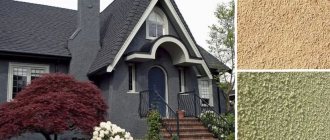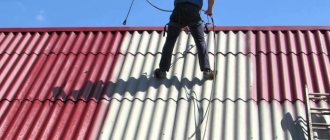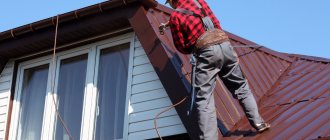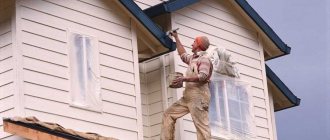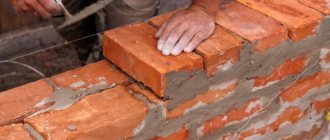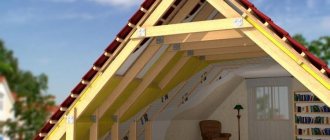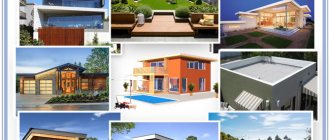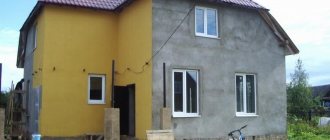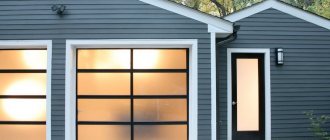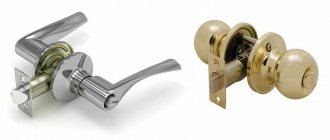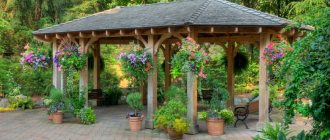Just a couple of decades ago, the choice of roof painting method was few. Weather conditions typical for our country greatly influence the appearance of the roof and, literally, the very next year after installation it becomes necessary to touch up peeling areas. Moreover, the updated places were brighter and therefore noticeable. It was this moment that created a negative impression of the repainted roof. Which is not surprising, since it is the roof, unlike the foundation and walls, that is most susceptible to extreme conditions. This means serious and thorough protection is necessary, which is why special roofing paints with an improved composition began to be produced. So, painting the roof of a house, how to do it competently and efficiently?
Roof paint for rust
Metal roofing materials are always relevant in the construction of residential buildings and outbuildings. The popularity of the coating is explained by its high performance characteristics, long service life and affordable price. The meager choice of color for metal materials can easily be solved by painting with special compounds. Roof paint should not only complement the overall appearance of the house, but also protect the material from weather conditions and corrosion.
Purpose
Over time, small defects and cracks appear on the surface of the roofing material, regardless of its type, which violate the integrity of the roof and also reduce its functionality. Roof paint can be a real salvation, protecting against the following phenomena:
- Corrosion. Over time, galvanized and other types of metal roofing become covered with pockets of corrosion, which not only spoil the appearance of the house, but often cause leaks.
- Rot. A smooth, non-porous coat of paint prevents the growth of mold microorganisms that destroy many roofing materials. Slate painted on time will last twice as long as unpainted slate.
- Discoloration. The sun's rays lead to gradual fading of the roofing material. Painting your roof can quickly update the appearance of your home, dramatically changing it.
Note! Most often, galvanized roofs, slate or ondulin roofs are painted. Paint for metal roofing not only eliminates pockets of corrosion, but also prevents their further spread. Slate and ondulin are painted mainly for decorative purposes to refresh the appearance of the roofing material.
Roof restoration using painting
Why do you need roof painting?
Metal roofing is made from galvanized steel coated with a protective oil layer. This impregnation is enough for about 10-12 months of operation, after which it is washed out under the influence of precipitation and ultraviolet radiation. Therefore, to properly protect the metal from adverse environmental conditions, the roof must be coated with paint. This processing allows:
- prevent rust and subsequent destruction;
- improve the aesthetic qualities of the roof;
- reduce subsequent costs for repairs or replacements.
It is recommended to paint the roof immediately after installation (weather permitting).
Types of roof paint
Roof paint is selected primarily taking into account technical characteristics, such as resistance to rust, temperature changes and precipitation. For the production of roofing materials, ferrous and galvanized metal is used. Therefore, paintwork materials for such work are produced from different materials. Depending on the type of composition, roofing protective compounds are:
Painting with an oil composition is the cheapest. However, such a coating cannot be called practical: it will have to be updated frequently, which will lead to new expenses.
Acrylic primer paints are considered one of the best solutions for protection against rust. The coating has a high cost, which is fully justified by its long service life. In addition, a roof coated with such a composition looks very aesthetically pleasing, which cannot be said about a roof coated with oil.
Oil paints
Oil paints and varnishes were often used in the past, and some craftsmen still use them today. However, treating metal with such a composition does not provide adequate protection. After application, the coating looks very aesthetically pleasing, but after a few months the paint will begin to fade and crack. Such manifestations are associated with low elasticity of the coating. However, as a temporary option, the treatment is not bad. A coating made of such material will have to be renewed every 1-2 years.
Alkyd paints
Such compositions are slightly more expensive than oil-based ones, but at the same time they provide the metal with better protection. Alkyd treatments have a wide range of colors, but the coating pigments are not very resistant to ultraviolet radiation. If you want to maintain the rich color of your roof, you need to apply a new coat every 2-3 years. Such compositions also have low elasticity. This disadvantage is especially evident during temperature changes.
Acrylic paints
A decade ago, such compositions were not durable. However, in the last few years, compositions have gained popularity among both professionals and private craftsmen. The wide distribution of paints is explained by their advantages:
- UV resistance provides pigments with durability for many years;
- the material contains anti-corrosion inclusions, which ensures resistance to precipitation and rust;
- aesthetic appearance of the finished coating.
Acrylic paint can last up to 10 years; this is the period after which professionals recommend renewing the coating.
For galvanizing
When choosing compositions for working with galvanized surfaces, several features should be taken into account:
- The structure of the paint should not contain substances that can enter into a chemical reaction with zinc, which will entail the destruction of its protective layer and damage to its integrity.
- Some types of acids, plasticizers, solvents, anti-corrosion agents and chemical additives can have a negative effect on zinc.
- The material must be elastic, since due to temperature changes the geometry of the painted roofing material will tend to change. On a coating that is not ductile, cracks will form, which will eventually lead to peeling.
Each type of paint intended for galvanized iron has advantages and disadvantages. Oil options create a dense, moisture-proof film on the surface and adhere well to metal. The weakness is that the substances they contain react with zinc.
The same thing happens with alkyd enamels as with oil-based materials: they provide excellent protection to the metal, have a wide range of colors, do not peel, but have a detrimental effect on the structure of zinc. The optimal solution is to use combined compounds, such as polymer ones. Their only disadvantage is their high cost.
Rubber acrylic paint
One of the varieties of acrylic paints is rubber. The composition is made from environmentally friendly materials. It is absolutely harmless to humans and animals. The substance can be diluted with water to obtain optimal density. One of the main advantages of the composition is its flexible, breathable structure, which allows the coating to maintain its integrity after temperature changes and heavy precipitation.
In order for the coating layer to remain undamaged for many years, it is necessary to choose the right coloring composition. Acrylic rubber paints differ in the type of material on which they should be applied. Painting compositions available:
- slate;
- wood;
- bitumen roll materials;
- metal tiles;
- galvanized sheets.
The paint is chosen depending on the roofing material. You should not buy a compound to work on another surface. The composition is developed based on the structure and specifics of the working surface. So, metal coatings contain more anti-corrosion components, and materials for wood contain substances against pests and rot. Properly selected coatings will protect the roof from bad weather and ultraviolet radiation and allow you to save money.
Rubber paints have high adhesion. They can be classified as deep penetration paints. After application, they form a durable flexible film on the surface that does not delaminate over time. The substance has a water-repellent layer that protects the metal from precipitation, sun and other negative phenomena. The main advantages of the composition are the following characteristics:
- long service life (about 10 years);
- increased waterproofing;
- high level of adhesion to the working surface;
- maintaining technical indicators even with large temperature differences;
- resistance to mechanical damage;
- rich color palette.
Among other things, the composition does not crack over time, which cannot be said about alkyd and oil compositions.
Preparatory work
If the roof is being painted for the first time, it is enough to remove dust from it. Old roofs must be cleaned of paint and rust using a wire brush or chemical rust removers. The sheets eaten away by rust are replaced with new ones. When preparing the roof for painting, it is necessary to check the gutters and other adjacent structures and communications, especially from the attic. The calculation of the substance depends on the roof area. The average coating consumption is indicated on the packaging.
Subsequent work depends on the type of processing selected. Any composition must be thoroughly mixed before application. First, gutters and slopes are painted. For stingrays, use a wide brush or roller. The roof is painted from top to bottom, then the ridge is painted.
Slate painting
Painting work carried out on slate includes mandatory preparation of its surface followed by priming. The canvases are inspected for damage. At the same time, special attention is paid to the slopes located on the north side due to the formation of moss colonies that need to be eliminated. Breaks and small cracks are repaired using a mixture consisting of cement, PVA glue diluted with water and asbestos. Before painting slate, it is necessary to remove not only debris, but also dust from its base.
The procedure for applying the paint and varnish composition is recommended to be carried out in cloudy weather at temperatures up to +15°C; the same technology is used for wavy panels as for flat ones. To process the ends and corners, you should purchase brushes of different sizes; the surface is first coated with the main layer, and after it dries, with the finishing layer.
Coloring Tips
Regardless of the paint chosen, the following recommendations should be followed when carrying out work:
- paint the roof not in the heat, but in warm weather of 10-25 degrees;
- do not apply the coating under the sun;
- do not treat the surface in the rain, the paint will form drops and bubbles, and will peel off when dry;
- for dilution, use the thinner recommended by the manufacturer;
- wait for the first layer to dry before applying the second (this will extend the life of the paintwork);
- Do not apply the paint thickly, this will avoid smudges.
Related article: What material is better to cover the roof of a house
Rubber acrylic paints allow you to give the roof a semi-matte, rough surface. A wide variety of colors will allow you to choose a shade that matches the style of the building. After treating the roof with a rubber coating, a durable layer is formed on it, protecting it from bad weather, pests and fungus. The coating is optimal for painting old roofs. If you need roof paint to combat rust, use acrylic compounds. Alkyd and oil-based paints are good for new roofs, but remember that coatings made from this composition will not last long.
Painting the inside of the roof
The steel roof covering rusts not only on the outside, but also on the inside. The most likely place for rust to appear is between the sheathing. The part of the roof lying on the sheathing cannot rust because it is protected by boards. Rust occurs due to warm air entering the attic through the ceiling. Practice shows that rusted places are most often located between the sheathing, but they can also be under the sheathing. To protect the roof from rust, you need to clean the steel between the sheathing with a steel brush and paint it twice. Painting twice will extend the life of a metal roof. If rust is found on a galvanized steel roof, you should immediately remove the rust, prime the cleaned area with liquid paint and cover it with two layers of paint.
How to Paint a Metal Roof on a House
To ensure that a metal roof lasts as long as possible, it is periodically painted. This allows you to constantly maintain the protective layer of the metal surface in good condition, which will protect the coating from negative external influences. In addition, regular painting will ensure that both the roof and the entire house look consistently good. Before you start painting your roof, consider the following tips:
1. Only dry weather is suitable for painting the roof, otherwise the quality of the coating will be poor and the operation will need to be repeated quickly.
2. Hot weather is also not very favorable for painting, because at high temperatures the paint material does not dry properly. The best season for roof restoration is autumn and spring, when it is not very hot.
3. When working on the roof, it is important to take safety precautions and ensure that you have fall insurance. Shoes with rubber soles are most suitable for such activities, because they do not slip on a metal surface.
If all the necessary conditions are met, then you can proceed directly to painting using the following technology:
• First of all, the roof is inspected: it is important to detect all defects, damage and cracks. Areas damaged by corrosion should be thoroughly cleaned with a wire brush.
• The entire roof base is coated with an anti-corrosion primer.
• To seal small cracks and damage, use a special putty paste (you can prepare it yourself from dry chalk and drying oil). In order for the sealing areas to stand out when painting, a little roofing paint is added to the paste for tinting.
• To eliminate larger damages, they resort to the patch method. They are cut out of tarpaulin, soaking it in drying oil and red lead. After the patch is well saturated, it is applied to the damaged area.
• Also, before painting, you should inspect all roofing ridges and joints, if necessary, tapping them with a mallet to compact them. • The primer solution is prepared by diluting the paint with drying oil and applied in a thin layer over the entire roof area.
• After the primer layer has dried, you can begin the main painting, and a terry brush with stiff bristles is best suited for this, since it is much more convenient to rub the substance into the roof surface than with the same roller.
• It is recommended to paint the roof slopes first, since the material consumption in these areas is the greatest. After this, the rest of the roof is painted. It is most convenient to apply paint to a brush in small portions, spreading it well over the metal roof. To maintain the uniformity of the paint material, it must be stirred periodically.
• The number of paint layers depends on the degree of wear of the roof. If it was installed recently, the paint is applied in 2-3 layers, pausing between paintings for at least 5 days.
• It should be taken into account that the inside of a metal roof also needs painting, the coating of which is usually limited to two layers.
• The type of coloring agent is selected in the store, depending on the type of metal roof.
Preparing for coloring
If the roof is already covered with slate, then it must be carefully prepared before painting. The main preparation procedure is to clean the roof surface from various debris and oil stains using a stiff metal brush. After the debris is removed, you need to thoroughly rinse the roof with water from a hose with good pressure and let it dry.
If there is no visible damage to the roof, then you can immediately proceed to the primer. But if small cracks and chips are found, they are treated with a mixture of PVA glue with the addition of cement and asbestos and dried thoroughly.
If the slate is attached to the roof with nails and rust has formed on their heads, then it must be removed.
To improve the adhesion of paint and material, it is better to cover the slate with a layer of primer and proceed to painting after it has dried.
Subtleties of painting the roof of a house
In the painting craft, there are various subtleties and secrets of professional skill that allow you to quickly and very efficiently complete any job. There are nuances to painting the roof of a house, and some of them are offered for study on this page.
It is important to understand that painting an old roof is an expensive operation, which, in principle, with the proper level of training, can be performed by any home craftsman. If you follow all technological aspects, the result will be excellent. You always need to start painting a roof with your own hands with preliminary preparation. It includes removing rust, sealing cracks, restoring the integrity of the coating, etc.
Primer and rust protection
Iron roofs. It is known that iron, especially if it is in the open air or in a damp room, is prone to oxidation and the formation of rust, and therefore painting a metal roof is necessary and should be done especially carefully with the best quality oil paint.
Iron sheets, before they are used to cover the roof, must be well cleaned of dirt, debris and dust and then primed on both sides with drying oil or oil paint diluted quite thinly. Any oil paint that covers well can be used as a primer. More often than others, red lead is used, diluted in 3 parts of drying oil.
After being attached to the rafters, the primed sheets are tinted in places damaged during work, and after that they are painted twice with oil paint. For the first painting of a galvanized roof, paint is taken with a large amount of drying oil; a second layer, and in some cases a third layer, is applied over the dried first layer. It is useful to paint gutters and areas adjacent to drainpipes once again, since in these places the paint deteriorates faster from accumulating water with dust and dirt.
Related article: How to make a reed roof with your own hands
The paint for painting a galvanized roof of a house must be thinly abraded; it should dry quickly enough and be hard; Drying oils for diluting paint should also be of good quality.
To protect iron from rust, the best paint is red lead. 16 kg of this red lead is diluted with 28.6 kg of drying oil; for primer, dilute with three parts of drying oil.
To update the color of surfaces painted with red lead, you can paint the iron roof completely with a brighter paint, such as mummy and others.
Of the green paints, verdigris is especially good as it is the most durable and beautiful in color. Medyanka is used for painting country and country buildings. In cities, with few exceptions, green roofs are quite rare. 16 kg of thick copperhead is diluted with 6-7.4 kg of drying oil.
Mineral, zinc and patented greens are also used to paint the roof, as they are cheaper. Graphite, lead and zinc gray are also recommended. 16 kg of these paints are diluted with 6-8 kg of drying oil.
When choosing paint, you need to take into account that dark colors absorb more sunlight compared to light colors and therefore dark colors heat up more, transferring heat to the iron, which, when expanding, can form cracks in the paint layer. In addition, dark colors quickly fade, which is often noticeable on roofs facing south. Thus, it turns out that light colors of paints for roofing are the most convenient and practical.
Do you know the answer?
Items
New questions
Site rating
- 1. Danil Lysogorsky 356
- 2. Anastasia Paranina 228
- 3. Parlefiano Fuello 174
- 4. Ksyu Pashnina 143
- 5. Anton Ogurtsov 106
- 6. Valery Rubtsov 104
- 7. No-Name No-Family 100
- 8. Alina Saibel 84
- 9. Mikhail Belyaev 77
- 10. Maria Korneeva 77
- 1. Maria Nikolaevna 13,550
- 2. Larisa Samodurova 12,795
- 3. Liza 12,355
- 4. Kristina Volosocheva 11,595
- 5. TorkMen 11,476
- 6. Ekaterina 11,361
- 7. Yulia Bronnikova 11,235
- 8. Vlad Lubenkov 11.125
- 9. Fox 11,070
- 10. Vyacheslav 10,865
Choosing time for painting
As for the time, they choose for coloring in the northern provinces from the beginning of May to mid-July; in the middle and southern provinces you can paint until October. You should avoid painting roofs during those months of the year when the nights become cold and damp, because the paint applied in the morning will not have time to dry until the evening, and such painting will be fragile.
In very dry and windy weather, painting must be done carefully, since settled dust, absorbing a lot of liquid paint at the time of applying it and mixing with it, gives a dirty appearance to the painted surface. In extreme heat, you should also avoid painting roofs, because very rapid drying of the paint is detrimental to its strength.
Repainting iron roofs requires careful removal of not only old peeling paint from the surface, but also rust. To do this, they usually use wire brushes, brooms and scrapers. Old paint that has faded but has not yet fallen off does not need to be cleaned off and you can limit yourself to only removing the accumulated dust and dirt. If the old paint is difficult to remove, then you have to resort to annealing with a red-hot iron.
Primer, putty and painting of an old roof
Wooden roofs, like any wooden surface in general, should be painted only after the wood has completely dried and, moreover, in calm, dry weather.
The surface of wooden roofs is almost always porous and uneven, and therefore greedily absorbs drying oil; When painting, primer and putty are of great importance. To obtain a satisfactory result, the roof must be covered 1-2 times with drying oil before painting, and when the primer is completely dry, all cracks are covered with oil putty. Painted areas are painted once with drying oil and then twice after painting.
The roof of a wooden house is painted with drying oil, red lead or oil paint. But for painting a slate roof, it is better to use special facade compositions based on water-based and lime.
The cleaned roof must be covered with drying oil, and when the latter dries, all cracks and cracks must be covered with putty. But the so-called red lead rubber putty turns out to be more convenient for this purpose. Although this putty dries slower than others, it is elastic and adheres tightly to the iron.
When the putty has dried, the roof must be covered with drying oil or liquid paint, and then twice with oil paint of the chosen color. In general, when repainting an old roof, the cost of paint materials is significantly higher than the cost of painting a new roof.
Roof painting procedure
It is recommended to paint the roof in warm, calm weather. On this day, the air temperature should not fall below 5-10 °C. But heat is also contraindicated: the temperature of the surface to be painted should not exceed 40 °C. You should not start “painting work” in very humid weather.
The ideal option is partly cloudy. So that the surface has time to dry before the evening dew, it is better to finish the work before lunch. If the coating is new, freshly laid, pre-coat it with a primer to enhance adhesion. First, apply paint to the slopes under the gutters.
Then you can move on to the main part of the roof. Try not to apply the paint too thickly - it will dry slowly and may crack. It is better to apply the paint in thin layers, allowing each layer to dry for 3-7 days (the entire job can take up to two weeks).
How to paint the iron roof of a house
Metal roofing is often installed on country houses. In order to protect it from the harmful effects of the external environment and increase its service life, the metal is coated with paint.
But not any paint can be used to paint an iron roof, so it often arises as to which paint and varnish material would be better for painting in order to improve the quality characteristics and improve the appearance of the roof.
Spelling of the adjective "dyed"
The productive word “paint” answers the question: what to do? This is an imperfective verb that forms the adjective "dyed".
These words denote a permanent feature of an object that is not related to the course of the action.
They do not have prefixes and dependent words, which are grammatical signs that these are adjectives that are written with the suffix -en-. Adjectives are formed similarly from imperfective verbs ending in -it:
- sharpen - a turned chair leg;
- pepper - pepper soup;
- to praise - a praised play;
- melt - processed cheese.
Metal Roofing Material Options
A variety of materials can be used to make a metal roof, including galvanized steel, ferrous and non-ferrous metals.
Ferrous metal is a mild steel that can be easily installed on a roof. This material does not contain substances that can protect against corrosion, so such a roof must be painted as soon as possible.
The roof is often covered with galvanized iron. Zinc coating helps protect the roof from external influences for a long time. But it is impossible to carefully install the coating on the roof without violating the integrity of the zinc coating, so after a while such a roof begins to slowly deteriorate as the zinc coating is destroyed. This is why you need to paint the roof after installing the roof after some time, usually 2–3 months. During this time, the zinc will have time to create a kind of film on the metal surface, which will improve the adhesion of the metal to the paint.
Related article: Insulating an attic roof with polystyrene foam
Roofs made of non-ferrous metals are not very common, but they look just great, and besides, copper is not subject to corrosion. To improve decorative qualities, copper sheets on the roof are specially aged. Under normal conditions, aging occurs after 30 years of use, but with the help of artificial aging you can achieve the desired effect very quickly.
paints and varnishes
0 votes
+
Vote for!
—
Vote against!
To finish the roof, materials are often used that require periodic painting. Painting the roof allows, first of all, to protect the finishing material from the negative effects of the environment, and also makes the roof of the building more aesthetically attractive. We’ll talk further about how to paint the roof of a house.
Table of contents:
- Tips for painting the roof of a house
- Metal roofs of houses: technology for painting them
- How to paint a slate roof
- Finishing the roof of a house made of galvanized steel
- Roof design of a private house - features of choosing the color of the roof
- Choosing paint for painting roofs
Tips for painting the roof of a house
1. Choose exclusively dry weather to carry out work. Otherwise, the quality of the applied paint will decrease significantly. Try to paint the roof in spring or autumn, as these periods are the most optimal for carrying out this work.
2. There is no need to paint the roof in the summer, since due to the high air temperature the paint does not dry properly and the moisture evaporates from it too quickly.
3. It is prohibited to paint the roof in wet weather or in the rain.
4. To avoid slipping on the roof surface and its mechanical damage, work is carried out in rubber shoes with soft soles.
5. To protect yourself during the process of painting the roof, you should install insurance, with the help of which a person will not fall.
Metal roofs of houses: technology for painting them
1. Before starting work, you should inspect the roof for defects, cracks and other damage. To get rid of rust, use a steel brush to carefully brush the roof surface.
2. After this, the roof is covered with a protective primer, which will prevent further development of corrosion.
3. To seal small holes on the roof, prepare a special solution in the form of putty. To do this, mix natural drying oil and dry chalk. In order for the putty to have a certain color, you need to add a little acrylic-based paint to it.
4. If the hole is too large, patches should be created. For these purposes, a tarpaulin is used, which is impregnated in a solution of drying oil and red lead from iron and lead. Soaking continues for ten minutes.
5. Next, the canvas is wrung out and glued to a certain area of the roof. After this, you should wait at least five days and start coloring.
6. In order for the connection to be strong, the roofing ridges should be compacted using a mallet or hammer.
7. Next comes the process of applying a primer to the surface; most often this composition consists of thick paint, previously diluted with drying oil. Try to apply the primer layer as thinly as possible.
8. To paint, it is best to use a terry brush with stiff bristles, with which the paint is rubbed into the roof.
9. It is not recommended to use a roller to paint the roof; due to its soft pile, the paint is applied in too thick layers and is unevenly distributed on the surface.
10. Start applying paint to the surface of the roof slopes; they will require more paint than other areas.
11. After the paint has dried in these areas, begin covering the entire roof. Apply paint in small portions, gradually blending it onto the surface.
12. To ensure that the paint does not lose its homogeneous consistency, stir it periodically.
13. The number of layers applied to the roof depends on its quality and wear. If the roof covering was installed recently, it is recommended to paint it two or three times, please note that the pause between application of layers is 5-7 days.
14. Please note that when painting galvanized steel, you should select certain painting compounds that are suitable for this work.
15. If you plan to paint the gutter system, then before doing this they are disassembled and thoroughly cleaned of debris and foreign matter.
16. If possible, paint the metal roof on both sides, since its inner side also needs protection. For interior painting, two coats are sufficient.
How to paint a slate roof
Applying paint to slate allows you to preserve its technical characteristics and increase the service life of the roof. Different colors and their combinations are suitable for painting slate.
The procedure for painting slate is followed by another equally important stage - its preparation for this type of work. Slate has high adhesion to paints and varnishes. He does not need special training. The only thing you need to do is clean the covering from debris, dirt, old leaves or branches. If there are grease stains on the surface, it is preferable to clean it with water, solvents and a brush.
If standard nails without galvanized coating are used to fix the slate to the surface, they must be replaced if there is rust on the surface.
Before painting, you should also choose the paint that is most suitable for painting slate. The best option is water-dispersion paint. It is with its help that the slate will become more attractive, and it will also protect it from external factors. There is a certain type of water-dispersion paint called slate. It can be used to paint tiled, slate and asbestos-cement surfaces.
Another option is enamel, especially the quick-drying type. This paint is characterized by a high content of binders, so after application, a film is formed on the surface of the slate, which is quite smooth and durable. With its help, the roof becomes smooth. In addition, slate acquires a glossy shine, which protects it from exposure to ultraviolet radiation.
To paint slate, you can use a roller, although if the roof is finished with wave slate, then the best option is a brush or spray gun. Start work from the top of the roof, this way there will be no leaks on the roof. Apply paint in a vertical direction, painting the slate in rows. Please note that before starting work, it is recommended to apply a primer to the slate, so it will absorb less paint. In addition, adhesion between slate and paint will improve.
Finishing the roof of a house made of galvanized steel
The preparatory stage consists of performing the following actions:
- cleaning the roof surface from debris, dirt and foreign objects;
- getting rid of corrosion with a brush;
- sealing cracks;
- applying a primer or anti-corrosion compound.
If using a brush cannot get rid of corrosion, it is recommended to use chemical compounds in the form of powders or liquids. With their help, it will be possible to remove not only rust, but also greasy heels from the coating.
There are two options for making steel roofs:
- Cink Steel;
- non-ferrous metal;
- black metal.
Roofing based on non-ferrous metals can be:
- titanium;
- copper;
- aluminum;
- zinc
This roofing is quite expensive, so the most common option is a ferrous metal roofing.
To paint a ferrous metal roof, it is recommended to use paints on:
- oil based;
- acrylic base;
- with anti-corrosion components.
Please note that the use of alkyd paints in the process of painting a steel roof is unacceptable. Since the paint begins to come into contact with the metal and it delaminates. As a result, the roof will be damaged.
Oil paints are quite short-lived, so a roof painted with this type of paint requires periodic painting. Therefore, the best option is to use acrylic paint with anti-corrosion additives.
If the roof surface is sufficiently smooth, then a paint roller or terry brush is used to paint it. Painting begins with painting the ridge and gutter system.
If there is galvanized sheet metal on the roof, then the paint should be chosen more carefully. Since zinc is a passive metal, only passive types of paints are used to paint it. They are quite elastic and adhere well to the roof. The best option is acrylic-based paint with a matte sheen. Before applying paint, it is recommended to apply a primer to the roof. Please note that when using a painted roof, you should periodically, in the spring, inspect it for the presence of rust, and if necessary, tint it.
Roof design of a private house - features of choosing the color of the roof
The procedure for choosing a roof color is a fairly important process that determines the integrity and attractiveness of the overall exterior. A correctly selected roof color can highlight its advantages and hide all its shortcomings.
First, you need to decide on the purpose of the roof; if you want it to stand out from the general background, then you should choose a brighter color, otherwise, you need to choose a warm and soft color.
Bright colors are suitable for painting slate: purple, green, electric blue, red. In addition, we must not forget about the facade; it must be in harmony with the roof. If the façade is painted in warm tones, then you should choose warm shades for painting the roof.
If the walls of the house are painted a soft blue color, then using a blue color for the roof would be an excellent option. Any roof color will harmonize with the white facade. In addition, a black or gray roof is an excellent universal option. We invite you to familiarize yourself with the most common roof color combinations:
- dark tones of the roof go well with light tones of the walls - a traditional option that is suitable for conservative people;
- to create the unity of the building, the roof and walls of the house are painted the same color, with slightly different or identical shades, this option is quite boring, although if it is played up correctly with the help of accessories, it is quite tolerable;
- Quite interesting, although rarely seen, is the option of painting the roof a dark color and the walls a light color - a bold decision for modern individuals.
In addition, if there are a large number of trees on the site that create a shadow falling on the building, then it is recommended to paint the roof in glossy shades. Otherwise, it is better to give preference to matte colors.
Please note that certain colors can change not only the roof, but also the shape of the entire house. The drainage system is also painted in the color of the roof or matched to the color of the facade.
Colors of house roofs photo:
If the roof of the house is painted in a dark shade, then you should take into account the fact that in the summer it will attract heat. Therefore, for the northern regions this is the best option. If the region has a hot climate, then it is better to paint the roof in light colors.
If the shade of the roof is quite bright, you should remember that over time it will change in color to a duller one. Lighter roof colors are less susceptible to ultraviolet radiation. Please note that on a white roof there is a risk of yellow spots appearing. The most practical and durable color is gray.
If the exterior contains a small number of small parts and accessories, then it is allowed to paint the roof with a bright color. We suggest studying the recommendations for choosing colors for roofs of houses:
1. If you cannot decide on the tone of the roof, then choose different shades of the same color.
2. Pay attention to the color combination of the roof, facade and exterior. The classical style is not characterized by bright colors, but in the Art Nouveau style, they are in demand.
3. In addition, the roof must be in harmony with neighboring buildings, their facade and roof.
4. If there is a pond nearby, then a blue or dark blue roof will harmonize perfectly with it. If there is a garden or park nearby, the green color of the roof will match the exterior.
5. Beautiful roofs of houses delight the eyes of both guests and people passing by the building. Therefore, the issue of choosing the color of the roof should be taken with particular seriousness.
Choosing paint for painting roofs
Before purchasing roofing paint, you should study the main types of paint compositions that are best suited for a particular type of roof.
The following types of paints are suitable for slate roofing:
1. Acrylic-based or water-dispersive paint is applied to the slate that was previously coated with primer. Among the advantages of acrylic-based slate paint are:
- ensuring protection of slate from moisture;
- a film forms on the surface, along which water flows faster, especially important for flat roofs;
- quick disposal of snow in winter, thus reducing the load on the supporting parts of the building.
2. Slate quick-drying enamel has the following advantages:
- due to the fact that the paint contains a large amount of binders, the surface is covered with a film that repels moisture from the slate and protects it from precipitation;
- the coating has high strength characteristics;
- slate receives additional protection from ultraviolet radiation.
3. The use of liquid plastic for roofing is primarily characterized by its low cost. This material has a bitumen or polystyrene base. The disadvantage of this material is that it is not environmentally friendly and is highly harmful to human health.
Arguments for painting a metal roof
In any case, a metal roof is one of the most reliable and durable roofing structures. Developers have long loved metal finishing for its ease of maintenance, fire resistance, and resistance to external influences, be it atmospheric or mechanical. Metal is also able to reflect the sun's rays, which is very good on hot summer days when it is difficult to hide from direct sunlight.
Metal roofs are more expensive than other alternative covering options, but their cost is fully recouped by long-term operation that does not require repairs. While other roofing materials require repairs every 15-20 years, metal can go without it for 60 years.
Since the roof is constantly exposed to various factors, such as temperature changes, oxygen, precipitation, exhaust gases, dust, sand and others, the roof needs protection. The role of this protection is to cover it with paint and varnish solutions.
After 20 years of operation, the roof may become covered with gray stains, and subsequently rust. That is why it is better to prevent the development of such negative consequences and cover the roof with paint.
The fact that a metal roof is painted is also supported by the fact that it looks much more presentable than one that is not painted. A roof without a coat of paint looks unfinished.
At the moment, there is a huge selection of paint and varnish products for external roofing work, from which you can choose the appropriate shade. The metal roof is coated with industrial-type acrylic paint.
Choosing paint for a metal roof
The choice of paint should be made based on the fact that the intervals between painting should be about 7 years, so the material must be of high quality in order to stay on the roof all this time. The selected paint must have all the qualities necessary for this type of composition. This:
- Resistance to external influences, including atmospheric conditions.
- Frost resistance.
- Protection of metal from corrosion.
In addition to the above-mentioned qualities, the coloring matter must be elastic after drying, since the metal has the property of expanding when heated. If non-elastic paint was used for painting, the surface of the finished layer is more likely to crack. Galvanized roofs have usually always been painted with alkyd and oil-based paints, but they often cracked, so new compositions have now been developed that are more flexible.
Of course, at the beginning of operation, alkyd and oil compositions will be quite elastic, but over time the layer will simply age. And the effect of alkyd paints on a galvanized surface was mentioned earlier - the paint will crack and come off.
The ideal option for painting a metal roof would be an industrial paint designed specifically for exterior metal work that contains anti-corrosion substances. This composition will create the final elastic coating that will protect the roof from corrosion and fire.
Acrylic-based paints designed for working with metal surfaces are expensive, but they create a high-quality coating without additional priming. If you cover a corrugated metal sheet with this paint, you will get an analogue of metal tiles, which will be much cheaper than the factory material. You can make it either glossy or matte for greater impact.
The most popular acrylic-based paint for exterior metal work has become “Tsikrol”. This is a matte composition containing anti-corrosion additives. It is perfect for exterior decoration of steel, aluminum and galvanized metal surfaces. The composition is used in painting gutters, roofing, gutters, downpipes and other metal elements.
This solution fully meets all the requirements for exterior metal paint. In addition, there will be no need to pre-prime the surface, and one coat of paint will be enough for perfect coverage.
Technical condition of the roof
If you want to paint a new roof, it will be much cheaper than one that requires repairs and high-quality cleaning. Let's consider the necessary actions to ensure that the coating is of high quality and lasts a long time:
- Clean from dirt, mold, and rust. Remove the old paint layer if the roof was previously painted. ( from 50-150 rubles per sq.m. )
- Carry out the necessary repair work to seal holes, cracks, replace rotten sheets ( from 90 – 2500 rubles per sq.m. )
- Wash and degrease the surface ( from 40 – 130 rubles per sq.m. )
- Primer work, which additionally protects the material from rotting ( from 45 – 120 rubles per sq.m. )
- Single-layer roof painting ( from 50 – 200 rubles per sq.m. ).
Paint application tool
It is also worth paying attention to what you can use to paint the iron roof of your house. For high-quality painting of roofing iron, you can use rollers, a pneumatic spray gun and brushes. Brushes should have stiff bristles, as they are easier and faster to paint large areas with a diameter of 60–65 mm. Horsehair brushes are used to paint small elements and remove stains.
For a flat roof, it is convenient to use a roller of a collapsible design, so that you can change the nozzle if necessary. The roller can also be further extended by adding a handle to it.
Painting tools in construction stores are presented in a wide range. When painting the roof, it is best to choose high-quality tools so that there are no problems with the painting work.
A household vacuum cleaner with a spray function and an appropriate nozzle can be used in the form of a pneumatic sprayer. You can also purchase a spray gun, with which you can quickly paint large areas.
Recommendations from experts
In order to paint the roof of an iron or slate house correctly, you must follow some rules:
- do not carry out work in direct sunlight or rain;
- do not apply the composition to a wet surface;
- when choosing a solvent, follow the recommendations in the instructions for using paints;
- Avoid paint smudges, and if they appear, fix them immediately.
Before carrying out such work, it is necessary to take care of their safety by preparing the appropriate accessories for this.
